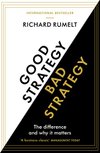
Saved by Eric Johnson and
Good Strategy/Bad Strategy: The difference and why it matters

Saved by Eric Johnson and
In competitive strategy, the key anticipations are often of buyer demand and competitive reactions.
If new insights or ideas are not needed, deduction is sufficient. There can be times when results are fine, when no new opportunities seem to have developed and no new risks have appeared. Then, the logical answer to the strategy question is simply “Keep it up, do more of the same.” But in a world of change and flux, “more of the same” is rarely
... See morestrategy is primarily about deciding what is truly important and focusing resources and action on that objective. It is a hard discipline because focusing on one thing slights another.
One of a leader’s most powerful tools is the creation of a good proximate objective—one that is close enough at hand to be feasible. A proximate objective names a target that the organization can reasonably be expected to hit, even overwhelm.
IKEA teaches us that in building sustained strategic advantage, talented leaders seek to create constellations of activities that are chain-linked.
It is often said that a strategy is a choice or a decision. The words “choice” and “decision” evoke an image of someone considering a list of alternatives and then selecting one of them. There is, in fact, a formal theory of decisions that specifies exactly how to make a choice by identifying alternative actions, valuing outcomes, and appraising
... See moreThe kernel of a strategy contains three elements: 1. A diagnosis that defines or explains the nature of the challenge. A good diagnosis simplifies the often overwhelming complexity of reality by identifying certain aspects of the situation as critical. 2. A guiding policy for dealing with the challenge. This is an overall approach chosen to cope
... See moreDespite all the emphasis on “competitive advantage” in the world of business strategy, you cannot expect to make money—to get wealthier—by simply having, owning, buying, or selling a competitive advantage. The truth is that the connection between competitive advantage and wealth is dynamic. That is, wealth increases when competitive advantage
... See moreBad strategy may actively avoid analyzing obstacles because a leader believes that negative thoughts get in the way. Leaders may create bad strategy by mistakenly treating strategy work as an exercise in goal setting rather than problem solving.